13. Volume
c1. Volume using Thin Disks
We first consider the problem of computing the volume of a solid of revolution using thin disks.
The region below a positive function \(y=f(x)\) above the \(x\)-axis between \(x=a\) and \(x=b\) is rotated about the \(x\)-axis. Find the volume of the solid swept out.
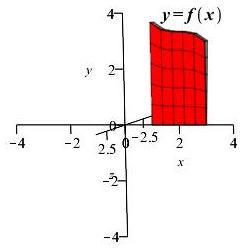
Since \(y\) is a function of \(x\), we will do an \(x\) integral. So we chop up the \(x\)-interval into small pieces of length \(\Delta x\). For the small interval located at \(x_i\), the corresponding small piece of the region is a rectangle and the corresponding small piece of the volume is a thin disk.
The thickness of each disk is \(\Delta x\) and the radius of the disk at \(x_i\) is \(r=f(x_i)\). So the area of the disk is: \[ A=\pi r^2=\pi f(x_i)^2 \] and its volume is: \[ \Delta V=A\,\Delta x=\pi f(x_i)^2\Delta x \] Adding up the volumes of the disks and taking the limit as the number of disks gets large (\(n\rightarrow \infty\)) and the thickness of each disk gets small (\(\Delta x\rightarrow 0\)) we obtain the volume of the solid of revolution: \[\begin{aligned} V&=\lim_{n\rightarrow\infty}\sum_{i=1}^n\Delta V =\lim_{n\rightarrow\infty}\sum_{i=1}^n\pi f(x_i)^2\Delta x \\ &=\int_a^b \pi\,f(x)^2\,dx \end{aligned}\]
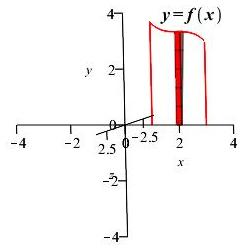
Now turn your head sideways:
![]()
The region to the left of a positive function \(x=f(y)\) and to the right of the \(y\)-axis between \(y=a\) and \(y=b\) is rotated about the \(y\)-axis. Find the volume of the solid swept out.
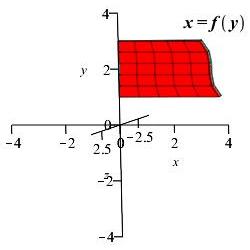
This time we chop up the \(y\)-interval into small pieces of length \(\Delta y\). Then the rectangles and disks are horizontal.
The volume of a disk is \(\Delta V=\pi f(y)^2\Delta y\) and the volume of the solid of revolution is: \[ V=\int_a^b \pi\,f(y)^2\,dy \]
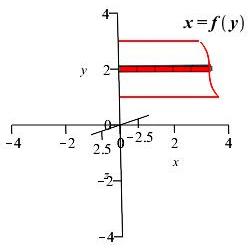
If the region below a positive function \(y=f(x)\) above the \(x\)-axis between \(x=a\) and \(x=b\) is rotated about the \(x\)-axis, the volume swept out is: \[ V=\int_a^b \pi f(x)^2\,dx \] If the region to the left of a positive function \(x=f(y)\) and to the right of the \(y\)-axis between \(y=a\) and \(y=b\) is rotated about the \(y\)-axis, the volume swept out is: \[ V=\int_a^b \pi f(y)^2\,dy \] Both formulas can be summarized as \[ V=\int_a^b \pi(\text{radius})^2\,dv \] where \(dv\) is either \(dx\) or \(dy\).
Notice that finding the volume of a solid of revolution by disks is really a special case of finding a volume by slicing \[ V=\int_a^b A(v)\,dv \] in which each cross-sectional area is the area of a circle, \(A=\pi(\text{radius})^2\).
The region below the parabola \(y=9-x^2\) above the \(x\)-axis is rotated about the \(x\)-axis. Find the volume swept out.
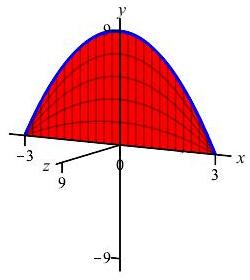
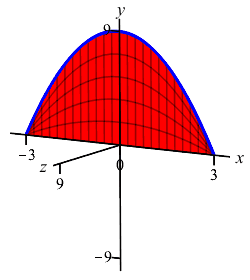
We cut up the \(x\)-axis (because the curve is a function of \(x\), not because we rotate about the \(x\)-axis) and see that the rectangles are vertical and they rotate into thin disks:
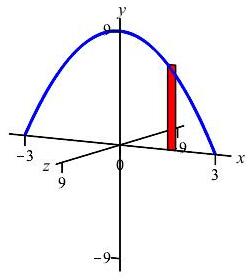
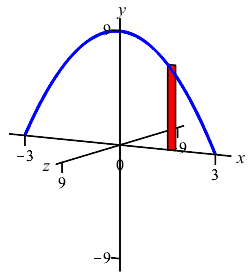
So the volume is \[\begin{aligned} V&=\int_a^b \pi f(x)^2\,dx =\int_{-3}^3 \pi(9-x^2)^2\,dx \\ &=\pi\int_{-3}^3 (81-18x^2+x^4)\,dx \\ &=\pi\left[81x-6x^3+\dfrac{x^5}{5}\right]_{-3}^3 =\dfrac{1296}{5}\pi \end{aligned}\]
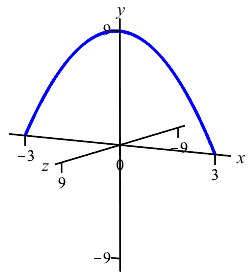
Here are some more examples:
| Example 1 | Example 2 |
Now you try:
The region between \(x=y^2\) and the \(y\)-axis for \(0 \le y \le 3\) is rotated about the \(y\)-axis. Find the volume swept out.
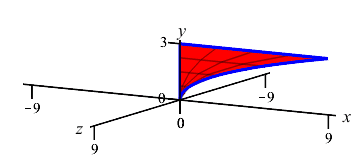
The curve is a function of \(y\); so this is a \(y\)-integral and we cut up the \(y\)-axis. Here is the region and one rotated disk:
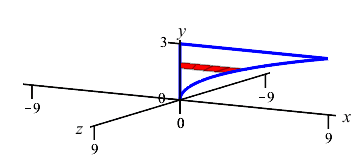
\(\displaystyle V=\dfrac{243\pi}{5}\)
The curve is a function of \(y\); so this is a \(y\)-integral and we cut up the \(y\)-axis. Here is the region and one rotated disk:
The radius of the disk is \(r=x=y^2\). So the area is \(A=\pi r^2=\pi y^4\) and the volume is \[ V=\int_0^3 \pi y^4\,dy =\left[\pi\dfrac{y^5}{5}\right]_0^3 =\dfrac{243\pi}{5} \]

Heading
Placeholder text: Lorem ipsum Lorem ipsum Lorem ipsum Lorem ipsum Lorem ipsum Lorem ipsum Lorem ipsum Lorem ipsum Lorem ipsum Lorem ipsum Lorem ipsum Lorem ipsum Lorem ipsum Lorem ipsum Lorem ipsum Lorem ipsum Lorem ipsum Lorem ipsum Lorem ipsum Lorem ipsum Lorem ipsum Lorem ipsum Lorem ipsum Lorem ipsum Lorem ipsum